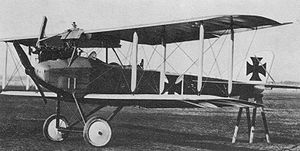| Albatros C.I | |
|---|---|
 | |
| General information | |
| Type | Reconnaissance aircraft |
| Manufacturer | Albatros Flugzeugwerke |
| Primary users | Luftstreitkräfte |
| History | |
| Introduction date | 1915 |
| Retired | 1917[1] |
| Developed from | Albatros B.II |
| Variants | Albatros C.III |
The Albatros C.I, (post-war company designations L.6 & L.7), was a twin-seat general-purpose biplanes designed and produced by the German aircraft manufacturer Albatros Flugzeugwerke. It was the first of the successful C-series aircraft operated by the Luftstreitkräfte.
During the opening year of the First World War, unarmed aircraft such as the Albatros B.II became increasingly vulnerable to the increasing numbers of armed military aircraft fielded by the Allies.[2] In response to a requirement formulated in late 1914, Albatros designed the C.I; based on the B.II, the C.I reversed the pilot and observer seating so that the observer occupied the rear cockpit which was provisioned with a machine gun, typically a ring-mounted 7.92 mm (0.312 in) Parabellum MG14. The aircraft was also furnished with a more powerful powerplant, such as the 150 hp (110 kW) Benz Bz.III or a 160 hp (120 kW) Mercedes D.III engine, and had relatively favourable flying characteristics.
During late April 1915, the type entered frontline service with the Luftstreitkräfte; it quickly proved itself to be a success and 228 aircraft were operational by the end of the year, comprising 42% of the total strength of C-type aircraft. Amongst its various roles, it became used as a fighter aircraft, noted pilots such as Oswald Boelcke and Manfred von Richthofen flew in the type. It performed various mission roles, including aerial reconnaissance, artillery spotting, and even bombing. Improvements to the C.I ultimately resulted in the Albatros C.III, which led to the aircraft being withdrawn from active combat on the Western Front during 1916. It continued to be used in the secondary trainer role, being outfitted with dual controls for training new pilots as well as observers. The C.I remained operational in German service through to the Armistice of 11 November 1918 that ended the conflict. The C.I saw further use in the hands of other operators, including the Lithuanian Air Force, Polish Air Force, and the Swedish Air Force.
- ^ Cowin 2000, [page needed].
- ^ Gray & Thetford 1970, pp. 17–18.